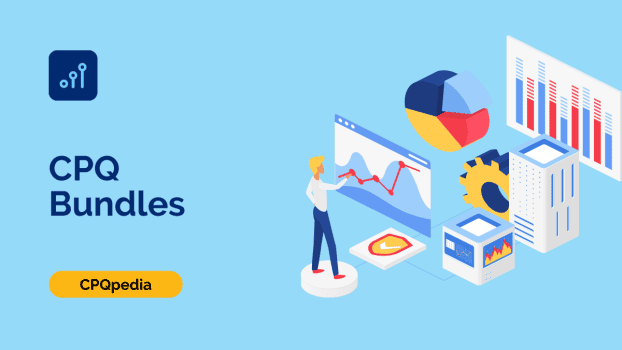What are CPQ Bundles?
CPQ bundles are groups of individual products or services that are sold together as a package (i.e., bundled). A CPQ bundle helps customers purchase multiple products at once, streamlining the sales process and making it easier for businesses to offer customers more value.
Businesses use CPQ bundling when customers buy complementary or related products. If they are part of an upsell or sales incentive, bundle pricing may be discounted from what the individual items would cost if they were purchased separately.
CPQ software contains preprogrammed product and pricing rules, which sellers and buyers use to determine two or more products’ compatibility. In this way, CPQ bundles ensure error-free quoting and product configuration processes.
Synonyms
- Configurable bundles
- Product bundles in CPQ
Why Configure Product Bundles?
Sales reps need to be able to customize product and service offerings with a combination of options and features and sell them as a bundle, as this flexibility allows them to better meet customer needs and preferences.
Sales reps can build stronger relationships with their buyers, enhance customer satisfaction, and ultimately drive higher revenue for the business by bundling products.
Let’s explore the benefits of product bundles for buyers and sellers.
Benefits to Buyers
- Cost savings. Buyers often receive discounts when purchasing a bundle of products or services, as opposed to buying each item separately.
- Convenience. Buying a package of complementary products simplifies the purchasing process, lessening the time spent selecting individual items.
- Customization. CPQ software lets buyers configure custom bundles, so they receive the exact combination of products and services they need.
- Accurate product configurations. The sales team programs CPQ’s built-in rules engine with product information, ensuring accurate quotes and configuration attributes every time.
- Pricing transparency. Configuring a package of products using CPQ gives buyers a cost breakdown and helps them understand the total cost of their purchase.
- Shorter lead time and faster order fulfillment. Accurate product configurations eliminate order fulfillment errors, and products frequently bundled together are easier to forecast demand for. Both factors reduce the time it takes to get the products or services to the customer.
Benefits to Sellers
- Increased sales. Compared to an individual product, a bundle is more attractive to buyers and increases average order value (AOV).
- Lower costs and increased margins. Selling several items in a single bundle can reduce overhead costs associated with order fulfillment, inventory management, and inventory waste. Bundle discounts may have higher margin potential than the individual items included in the package.
- More control over pricing. Bundles can be priced to achieve maximum profitability, giving sellers more control over margins and revenue.
- Upselling and cross-selling opportunities. Bundle configuration makes it easier for sales reps to add products or services to the sale by demonstrating their value and compatibility with other items in the bundle.
- A more productive sales force. CPQ software automates the quoting and configuration process, which frees sales reps to focus on selling activities and reduces the risk of errors.
- Sustained competitive advantage. Offering customized bundles can help businesses vertically differentiate.
Types of CPQ Bundles
In CPQ, there are three basic types of bundles: static, configurable, and nested. There are also virtual and dynamic bundles, which offer more flexibility.
Static Bundles
A static bundle (also called a traditional bundle) is a predefined package of products and services that cannot be altered after the initial configuration.
This type of bundle is best suited for situations where specific products must be sold together to minimize errors and ensure compatibility, such as a cell phone and its respective charger or a gaming console and controllers.
Configurable Bundles
Configurable bundles offer a higher degree of customization for customers, allowing them to tailor the bundle according to their preferences or needs.
While these bundles do have certain constraints to prevent incompatible configurations, they provide more flexibility compared to static bundles.
A configurable bundle works best when there are alternative product options available for customization, such as a phone case bundled with a cell phone.
Nested Bundles
Think of a nested bundle as “a bundle within a bundle” — to create one, the parent product of one package can be added as a product option for another bundle.
This type of bundle is particularly useful for more complex sales where buyers need to choose among multiple subgroups to include in the final bundle.
Consider a customer buying a new car. A nested bundle would allow the customer to choose different subsets of features within a single product option (i.e., the car), such as interior packages that include different seat materials, dashboard designs, and entertainment systems.
Virtual Bundles
A virtual bundle is a group of products that are sold together but not packaged in the same parcel.
They make it easy for customers to shop a brand’s catalog and work well when businesses use a 3PL or other third party (such as Amazon) to fulfill orders.
Dynamic Bundles
Dynamic bundles let sales reps choose their own bundles based on filter criteria, such as customer type or desired features.
This type of bundle is great for upselling and cross-selling, as sales reps can quickly configure packages that meet their customers’ needs without having to manually search for individual products or sift through other preset bundle products.
Best Practices for Configuring Product Bundles in CPQ
When configuring a bundled product or service package, it’s important to remember the goal: simplify and streamline the sales process for both buyers and sellers.
Here are a few best practices to keep in mind when setting up product bundles in CPQ:
Understand Bundle Contents
To understand bundle contents, it helps to think of them like a tree. The bundle parent is the root, and the children are all of its sub-products (or product options within the bundle).
For example, a gaming console may be the parent product, and the controller, game discs, and other accessories would be the product options.
Determine Pricing for Bundles
Bundles usually have different pricing strategies from individual products, as they provide a reduced or modified price to incentivize customers to buy multiple items together.
To set the pricing for a bundle, you can assign a collective price for the entire package, which may include a discount.
For bundles with optional products, these can be included in the price list as individual price list components.
When a product bundle is added to an opportunity, quote, order, or invoice, the price of the bundle is determined based on the mandatory products within it.
In cases where the bundle contains optional products, the overall price is calculated by combining the total price of these optional elements with the core price of the product bundle.
Ensure Bundles Comply With Discounting and Approval Processes
Although CPQ bundles typically have preset rules that restrict certain configurations, dynamic bundles can be configured and reconfigured during the sales process.
For this reason, it’s important to ensure that all bundles comply with any discounting or approval processes that are in place within your organization.
Set up Bundle Options in CPQ
When setting up bundle options in CPQ, you’ll need to select the appropriate parent product and configure any sub-products or child products that are included in the package.
You will also need to define rules for configuring one or more of the bundle’s components, such as which item can only be added if another is selected, the max quantity of a component, or the minimum/maximum quantity of options.
In Salesforce CPQ, businesses can extend the capabilities of their CPQ bundles with CPQ Package Settings, a set of plug-ins that adds more options and functionality to product bundles.
Subscription package settings, for instance, help companies bundle, quote, and manage subscription packages for recurring revenue.
FAQs
As a seller, CPQ bundles work by combining multiple products and services into a single package option. This could be a predefined package of products that cannot be altered or a customizable package that allows customers to select their own items. When sellers pick the right bundle for their customers, they can turn it into a quote, contract, purchase order, or invoice with CPQ software.
A bundle pricing strategy is a sales strategy that incentivizes product bundle sales over individual products to increase a company’s average order value (AOV). Bundle pricing strategies generally involve discounting, upselling, cross-selling, or all three.
In Salesforce CPQ, a static bundle is a preset package of products and/or services that cannot be altered by the customer. This type of bundle is best suited for selling simple products or packages where there are no alternative options or customization available (or, in some cases, possible).

Andrew is a professional copywriter with expertise in creating content focused on business-to-business (B2B) software. He conducts research and produces articles that provide valuable insights and information to his readers.

